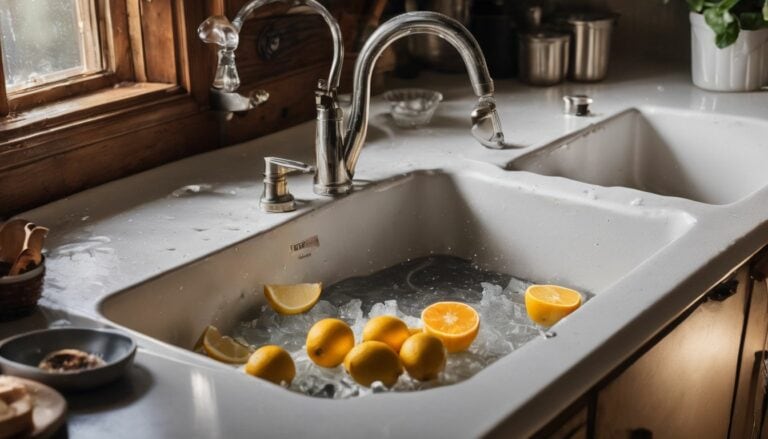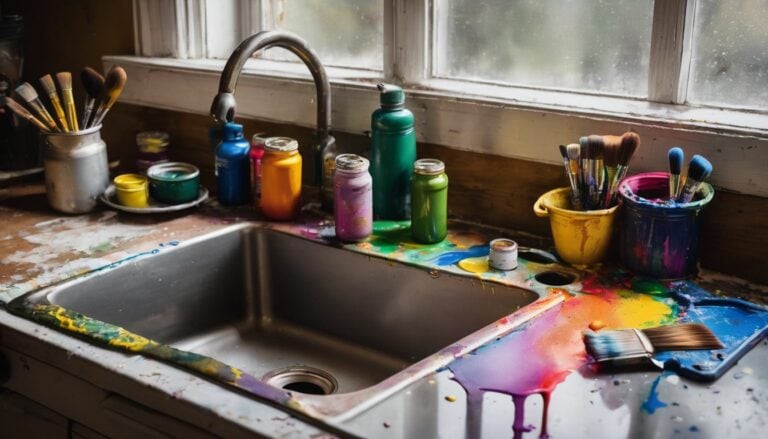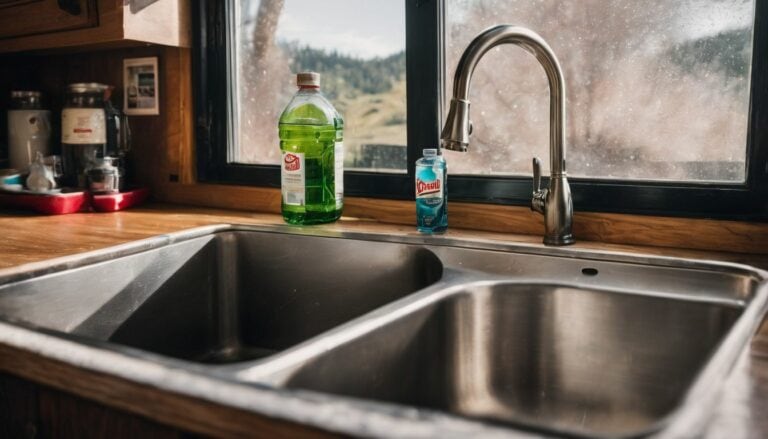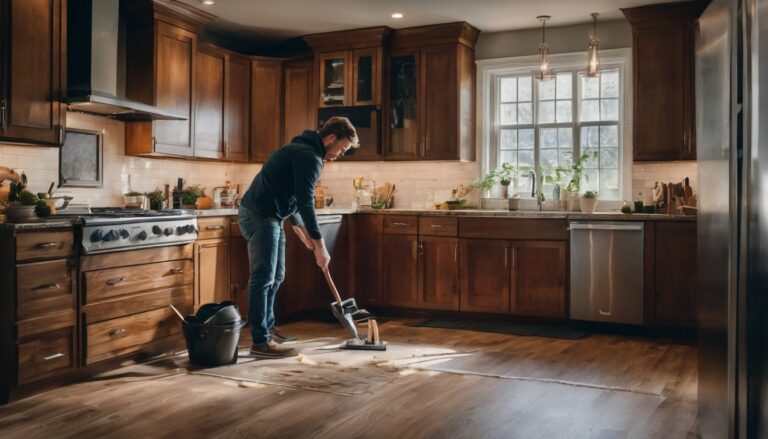Fix It Fast: Why My Kitchen Sink Leaks Underneath
Ever ended up with an unwanted puddle under your kitchen sink and not had the foggiest idea why? I totally sympathize. It’s like a unexpected, watery visitor that you didn’t invite but just won’t leave! Do you know that often this little mystery can be traced back to something as simple as a corroded valve or loose faucet? Join me on an exploratory journey through this article, where we tackle the various possible culprits behind these frustrating leaks and provide handy solutions to put them in their place.
Are you ready to show that obtrusive puddle who’s boss? Let’s roll up our sleeves and get started.
Key Takeaways
- Corroded valves, damaged O-rings, worn gaskets or washers, backed-up p-traps, old drain putty, high water pressure, and loose water supply connections can cause kitchen sink leaks.
- Conducting flow tests, basin tests, and faucet stress tests can help identify the source of a leak under the kitchen sink.
- Repairing faucet leaks by replacing faulty parts and re – sealing drain seals using plumber’s putty or silicone caulk can fix leaks.
- Preventing leaks by regularly checking connections, avoiding harsh cleaners, being mindful of what goes down the drain, and maintaining proper ventilation in the kitchen.
Common Causes of Kitchen Sink Leaks Underneath

Corroded valves, damaged O-rings, worn gaskets or washers, backed-up p-traps, old drain putty, high water pressure, and loose water supply connections are some of the common causes of kitchen sink leaks underneath.
Corroded valve
A rusty valve can cause leaks under your kitchen sink. This happens when the metal part of the valve gets old and rusty. The rust eats away at the valve, making it weak. Then, water starts to slip past it and leak out.
If you see a corroded valve under your sink, that might be why water is pooling there. It’s not safe or good for this to keep happening: You need to fix it fast! Often times putting in a new valve can stop the leak.
But if this sounds too hard, you might want to get help from a plumber. They know what they’re doing and can make sure everything is fixed right.
Damaged O-ring
The O-ring is a tiny circle of rubber. It helps to stop water from leaking out of your sink. Sometimes this ring can get damaged. When it does, you may see water dripping or pooling under your sink.
Fixing a damaged O-ring is not hard! You need to first stop the water flow by turning off the valve under the kitchen sink. Then, take out the old faulty O-ring and replace it with a new one.
Once you have done that, turn on the water again and check if there are any leaks.
Worn gaskets or washers
Gaskets and washers in a sink may wear out over time. They help to keep water from leaking at the joints of your sink parts. If these parts get old, they can’t do their job well anymore.
This means that water may start to leak out. The leak might make a pool under your sink. A good fix is to tighten any loose nuts on the gasket or washer first. But if this doesn’t work, you might need new parts.
Changing worn-out gaskets and washers can stop the leaks and save your kitchen from future water damage.
Backed-up p-trap
If you notice a leak under your kitchen sink, one common cause could be a backed-up p-trap. The p-trap is the curved pipe located underneath the sink that prevents sewer gases from entering your home.
When the p-trap becomes clogged with debris or grease, it can cause water to back up and leak out. This can lead to unpleasant sewage odors and even bubbling water in your sink. Inspecting the p-trap for any signs of blockage or damage is important in identifying the cause of the leak.
Make sure to check the connections and piping as well, as any misalignment or damage could also contribute to the problem. If everything looks good with the p-trap, there may be other factors causing the leak under your sink that need further investigation.
Old drain putty
One of the common causes of kitchen sink leaks underneath is old drain putty. If the putty is old, thin, or starts to dry out, it can lead to water leaking from the sink drain. Worn-out plumber’s putty can be the culprit behind these leaks.
Even after replacing the drain/strainer and using new plumbers putty, leaks around the drain can still occur. Another factor that can cause water to leak under the sink is old caulk.
High water pressure
High water pressure can be a common cause of kitchen sink leaks underneath. When the water pressure in your plumbing system is too high, it can put stress on the pipes and connections.
This excessive pressure can lead to leaks under your kitchen sink. The improper piping or faulty plumbing connections may contribute to this issue. Water buildup under the cabinet can also create additional pressure in the system, causing more stress on the pipes and potential leaks.
It’s important to address high water pressure promptly to prevent further damage and avoid costly repairs.
Loose water supply connections
One common reason why kitchen sinks leak underneath is due to loose water supply connections. Over time, the connections that hold the pipes together can become loose, causing water to drip or leak out.
This can lead to water damage and potential mold growth if not addressed promptly. It’s important to check the water supply connections regularly and tighten them if necessary to prevent leaks from occurring in your kitchen sink.
Keeping an eye on these connections will help ensure a reliable and leak-free water system in your kitchen.
How to Find the Source of a Leak Under the Kitchen Sink
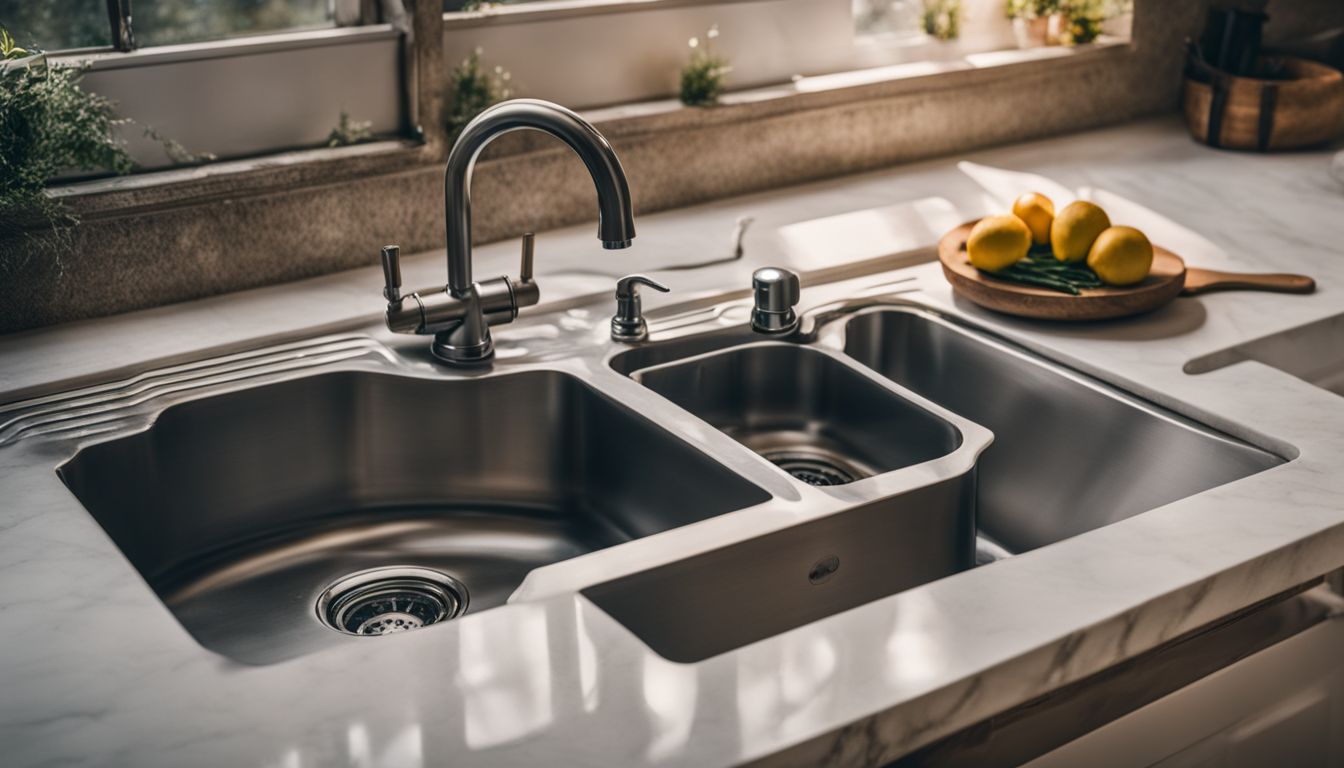
To find the source of a leak under your kitchen sink, conduct a “flow test” by running water and checking for any drips or puddles. Additionally, try a “basin test” by filling the sink with water and checking underneath for any leaks.
Finally, conduct a faucet stress test by turning on the faucet to see if it causes any leaks. Read more to learn how to fix these issues!
Conducting a “flow test”
To find the source of a leak under your kitchen sink, you can conduct a “flow test.” First, wipe up any water and dry everything beneath the sink. Then, turn on the faucet and let the water flow into the sink.
Pay close attention to where the water is coming from – is it dripping from a specific spot or pooling in a certain area? Next, check all the drain pipes by running water down each one individually.
This systematic testing will help you identify where exactly the leak is coming from. The best part is that conducting a flow test is simple and doesn’t require any fancy tools or equipment.
Conducting a “basin test”
Finding the source of a leak under your kitchen sink can be tricky, but conducting a “basin test” can help you pinpoint the problem. To do this, fill both basins of your sink with water and let them drain simultaneously.
During the test, make sure to run your garbage disposal as well to check for any leaks or drips. While the sinks are draining, gradually move down the plumbing and use a flashlight to spot any leaks or drips along the way.
This will help you identify if there are any issues with the plumbing system under your kitchen sink. You can also perform this test to check if your faucet is leaking by placing a shallow bowl under it and observing if it collects any water.
Conducting a faucet stress test
To find the source of a leak under your kitchen sink, one step you can take is to conduct a faucet stress test. This involves turning on the faucet and checking for any signs of leaks or drips around the base or handles.
If there are any visible leaks, it could indicate a problem with the faucet itself, such as worn-out gaskets or O-rings. Remember to also check for leaks underneath the sink where water may be pooling.
By conducting this simple test, you can pinpoint any issues with your faucet that may be causing the leak and take appropriate steps to fix it.
Solutions for Fixing a Leak Under the Kitchen Sink
To fix a leak under the kitchen sink, there are several solutions you can try. First, repair any faucet leaks by tightening the connections or replacing faulty parts. Next, re-seal any drain seals using plumber’s putty or silicone caulk.
If you have a drain leak, you may need to replace worn gaskets or washers.
Repairing faucet leaks
When you have a leaky faucet, it’s important to address the issue promptly to prevent further water damage and wastage. One common cause of faucet leaks is a corroded valve seat. To repair this, you can start by shutting off the water supply.
Then, remove the handle and unscrew the packing nut to access the valve seat. If it’s corroded or damaged, replace it with a new one. You may also need to replace the O-rings and washers if they are worn out or damaged.
Make sure all the connections are tight before turning on the water supply again. By taking these steps, you’ll be able to fix those annoying faucet leaks and save both water and money in the long run!
Re-sealing drain seals
To fix leaks under your kitchen sink, one effective solution is re-sealing the drain seals. Dried putty along the drain and deteriorating caulk sealant can often lead to leaks, so re-sealing the seals can help prevent water from seeping through joints and causing leaks.
This is especially important if the leak is caused by a damaged compression nut at the drain joint. By following tips and instructions, you can successfully re-seal your drain seals and stop those pesky leaks in your kitchen sink drains for good!
Fixing drain leaks
To fix drain leaks under your kitchen sink, you can start by inspecting the drain pipe for any cracks or holes. If you find any, you can use a plumbing epoxy or tape to seal them up.
Another common cause of drain leaks is a loose connection between the pipes. To fix this, tighten the nuts and fittings that are holding the pipes together. If there are worn-out gaskets or washers, you can replace them with new ones to create a watertight seal.
Additionally, applying plumber’s putty around the edges of the drain basket can help prevent water from leaking out. If these steps don’t solve the problem, it may be best to call a professional plumber for further assistance and repairs.
Dealing with Water Damage from a Leaking Kitchen Sink
Dealing with water damage from a leaking kitchen sink is important to prevent further problems. When there’s a leak, it can cause water to seep into the surrounding area, leading to mold and mildew growth.
This can also cause the wood or other materials in that area to rot away. To deal with the water damage, it’s crucial to fix the leak as soon as possible and dry out any wet areas thoroughly.
You may need to replace damaged materials if necessary. Remember, addressing water damage promptly will help ensure a safe and healthy kitchen environment.
Tips for Preventing Leaks Under the Kitchen Sink
To prevent leaks under the kitchen sink, there are some simple tips you can follow:
- Regularly check the water supply lines and drain lines for any signs of leakage. If you notice any drips or moisture, tighten the connections.
- Avoid using harsh liquid drain cleaners, as they can erode the pipes and potentially lead to leaks. Instead, try using natural alternatives like baking soda and vinegar to clean your drains.
- Be mindful of what you put down the drain. Avoid pouring grease, oil, or coffee grounds down the sink, as they can clog the pipes and cause leaks.
- Keep an eye on your garbage disposal. Don’t overload it with too much food waste at once, as this can strain the system and lead to leaks.
- Maintain proper ventilation in your kitchen to prevent excess humidity that can cause water damage. Use exhaust fans or open windows when cooking or running the dishwasher.
Other Possible Causes of Water Leaks Under the Sink
Sink overflow can also be a potential cause of water leaks under the sink, especially if it is clogged or malfunctioning.
Sink overflow
Sometimes, the cause of a kitchen sink leak underneath can be an overflow issue. This happens when too much water flows into the sink and exceeds its capacity, causing it to spill over onto the floor.
It’s important to address this problem promptly to prevent further damage. To fix an overflow issue, you can try adjusting the water flow or installing an overflow prevention device.
Additionally, make sure to regularly clean your sink and check for any clogs that may contribute to an overflow situation. Preventive measures like these can help keep your kitchen sink free from leaks and water damage in the future.
Leaks from other items near the sink
Sometimes, leaks under the kitchen sink can actually come from other items near the sink. For example, a leaky dishwasher hose or a faulty garbage disposal can cause water to accumulate beneath the sink.
It’s important to check these nearby items if you notice a leak under your kitchen sink. Make sure all connections are secure and in good condition. If you find any issues, it may be necessary to repair or replace these items to prevent further leaks.
How to Fix a Leaky Kitchen Sink DIY
If you want to fix a leaky kitchen sink yourself, here are some steps you can follow:
- Turn off the water supply: Before starting any repairs, make sure to turn off the water supply to your kitchen sink. This will prevent any more water from leaking while you work.
- Identify the source of the leak: Look for where the water is coming from. It could be a faucet leak, a drain leak, or a leak around the edges of the sink.
- Tighten loose connections: If you have a water supply line leak, use pliers or an adjustable wrench to tighten any loose nuts or connections. This might stop the leak.
- Repair faucet leaks: If the water is leaking from your faucet, you may need to replace certain parts such as O-rings or gaskets. Consult the manufacturer’s instructions or seek professional help if needed.
- Re-seal drain seals: If there is a leak in your sink drain pipe connection, try re-sealing it with plumber’s putty or a new gasket. Make sure to remove all old putty before applying a new one.
- Fix drain leaks: A leaking drain pipe may need to be tightened or replaced if it is damaged. Use plumber’s tape or joint compound to create a watertight seal.
- Test for leaks: After making any repairs, turn on the water supply and test for any remaining leaks. If everything looks good, pat yourself on the back for fixing that kitchen sink!
When to Call a Professional Plumber
Sometimes, it’s best to call a professional plumber if you have certain problems with your kitchen sink. Here are some situations where it’s recommended to seek their help:.
– Corroded valve seat
– Loose water supply connection
– Damaged O-ring
– Faucet leak
– Clogged P-trap
That’s it!
Conclusion
In conclusion, a leaking kitchen sink can have various causes, such as a loose faucet or damaged seal. It could also be due to issues with the drainage pipes or worn-out gaskets and washers.
Identifying the source of the leak is important in order to apply the right solution, whether it’s repairing a faucet leak or re-sealing drain seals. Remember to call a professional plumber if needed and take preventive measures like using putty to avoid future leaks under your kitchen sink.
FAQs
1. Why is my kitchen sink leaking underneath?
A common cause of a kitchen sink leak underneath is a loose or damaged plumbing connection, such as the drainpipe or supply lines.
2. How can I fix a leak under my kitchen sink?
You can fix a leak under your kitchen sink by tightening any loose connections, replacing damaged parts like gaskets or washers, or applying plumber’s tape to seal gaps.
3. Can I stop the leak temporarily until I get it fixed?
Yes, you can place a bucket or container under the leaking area to catch water and prevent further damage while waiting for repairs.
4. What should I do if the leakage persists after trying to fix it?
If the leakage continues even after attempting DIY fixes, it’s best to call a professional plumber who can assess and resolve the issue effectively and safely.
5. How much does it cost to repair an underneath kitchen sink leak?
The cost of repairing an underneath kitchen sink leak varies depending on factors such as the extent of damage, required replacement parts, and labor fees from plumbers in your area. It is advisable to consult with professionals for accurate estimates based on your specific situation.



